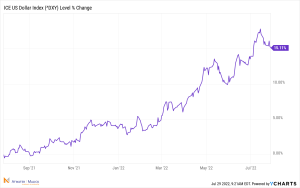The Dominant Dollar
Published On: July 29, 2022
Written by: Ben Atwater and Matt Malick
There are innumerable moving parts in financial markets. To get a peak at what is happening in today’s markets and to better understand the complexity of events, it can be helpful to isolate an impactful area and explore it.
Today, we look to the strength in the U.S. dollar and some of its wide ranging implications.

As you can see in the chart above, the dollar is climbing high against a basket of currencies. The dollar index, DXY, reflects a weighted geometric mean of a basket of currencies including the euro, yen, pound, Canadian dollar, Swedish krona and Swiss franc.
The primary reason for the dollar’s ascent is the U.S. Federal Reserve raising interest rates at a faster clip than other industrialized countries in order to battle inflation.
The Fed, theoretically, has room to raise rates aggressively because, in comparison to China, Europe and Japan, the U.S. is stronger economically and might be able to withstand the impact of higher rates without a deep recession.
Higher interest rates in the U.S. attract capital (or money flows) from abroad. For example, if an institution in Japan wants to buy U.S. Treasuries to take advantage of higher American interest rates, they must convert its yen to dollars in order to buy U.S. Treasuries. This creates greater demand for dollars and, all else being equal, raises the value of the dollar versus the yen.
It is not just U.S. investments, like Treasuries, that drive demand for dollars. As the de facto international reserve currency, market participants need dollars to buy oil and other commodities, the prices of which have been exploding over the last year.
Everything is relative. Due to the strong dollar the inflation problem in the U.S. is actually not as bad as in many other countries.
The need to buy dollars in order to then turn around and buy commodities (often denominated in dollars) creates a vicious circle of demand for dollars that makes commodities even more expensive for other countries. A tank of gas or a bushel of wheat in Europe is a far more painful purchase than it is in the U.S.
When we look at our portfolio, a strong dollar helps multinational companies buy many inputs cheaper than their competitors around the world, but a strong dollar also hurts foreign sales substantially.
A U.S. multinational might sell its medications in England and get paid for those medicines in pounds. When the multinational coverts the pounds to dollars to repatriate the funds, they lose money, which has a negative impact on the company’s earnings.
It also makes those drugs, and other goods, more expensive in other countries, just like with gas and commodities. So, in effect, America’s leading export right now might be inflation.
The irony is that inflation did not start with the Fed. But the Fed’s fight against inflation is accelerating inflation elsewhere.
Inflation had many causes: tariffs and a trade war, a shift in demand from services to goods during the height of Covid, China shutting down cities to prevent the spread of COVID and U.S. government largesse in the form of the Payroll Protection Program and a myriad of government transfer payments for fiscal stimulus and unemployment benefits. All of these combined to create a supply and demand imbalance.
While we might gripe about government missteps, we should also be grateful for the strong dollar. Supply and demand imbalances can cause inflation, but it is a kind of inflation that the Fed can manage by slowing the economy and thereby slowing demand. It is our guess the Fed will beat inflation this time around.
The kind of inflation brought on by a currency collapse is generally not fixable. This is the very inflation that struck Weimar Republic Germany in the late 1920s and the kind of inflation that has plagued the likes of Argentina and Russia for generations.
A strong dollar that serves as the de facto global currency allows America enormous economic latitude. Let us hope it stays that way for a long time.
Mar 21, 2024
Feb 27, 2024